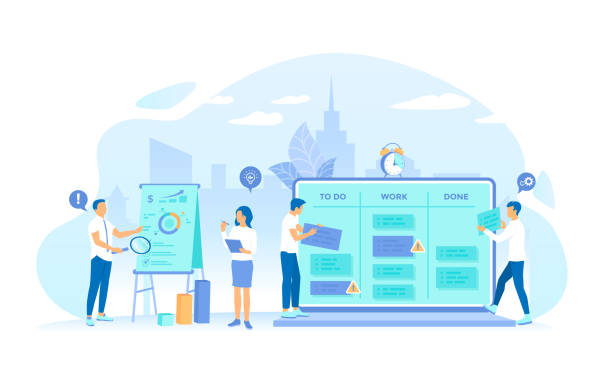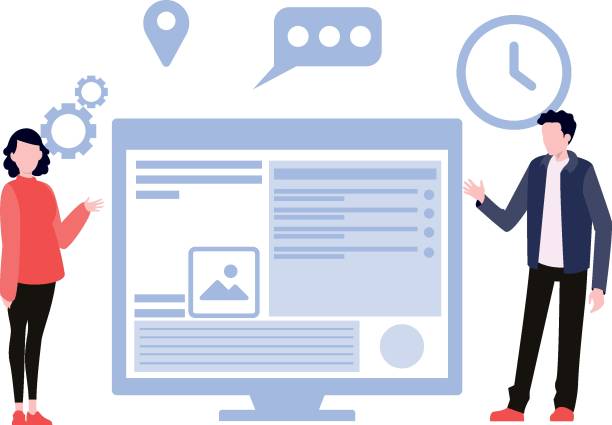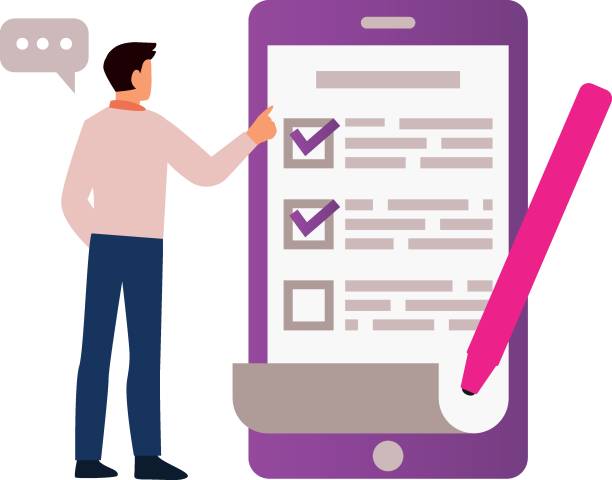Introduction to Multilingual Website Design: Why Do We Need It?

In today’s world, where geographical boundaries have no meaning in cyberspace, multilingual website design is no longer a luxury choice but a necessity.
This #multilingual #website #design project allows your website to connect with a wider audience from around the world.
The main goal of launching such a website is to access new markets and offer services or products to people who speak different languages.
This approach not only increases website traffic but also significantly helps strengthen the brand at an international level.
Beyond a simple translation, a successful multilingual website requires accurate localization, which includes adapting content to the culture, values, and even currency units and dating systems of the target audience.
This specialized and complex process requires a deep understanding of the needs of international users and the related technical challenges.
For example, the way dates are displayed in a European country differs from an Asian country, and ignoring these details can severely reduce the user experience.
Therefore, if you are looking to expand your business globally, investing in a professional multilingual website will be a very important step.
This approach allows you to convey your message directly to international audiences without intermediaries and to increase your business credibility in global markets.
Does your company website perform as your brand deserves? In today’s competitive world, your website is your most important online tool. Rasaweb, specializing in professional corporate website design, helps you to:
✅ Gain customer credibility and trust
✅ Convert website visitors into customers
⚡ Get a free consultation!
Numerous Benefits of Multilingual Website Design for Businesses

The benefits of multilingual website design are far more extensive than they initially appear.
Firstly, it provides access to global markets.
By offering content in various languages, your business can reach customers worldwide whom it might otherwise never connect with.
This increased access means a potential increase in sales and revenue.
Secondly, multilingual websites significantly improve the website’s SEO ranking.
Search engines prefer websites that provide quality content in multiple languages, which leads to greater visibility in global search results.
This is a specialized topic that requires specific strategies for keywords and content in each language.
Thirdly, they increase business trust and credibility.
When potential customers can find information in their native language, they feel more comfortable and connected to your brand.
This is especially crucial in sensitive industries such as financial services or medical products that require precise explanations.
These benefits collectively mean a significant Return on Investment (ROI) for businesses looking for international growth and expansion.
Alongside these, analyzing user behavior in each language can provide valuable analytical data to improve future marketing strategies and offer a comprehensive view of target markets.
Technical Foundations of Multilingual Website Implementation and Domain Structures

The technical foundations of multilingual website implementation are of high importance, and errors in this section can jeopardize the entire project.
One of the first crucial decisions is the choice of domain structure.
There are three main methods: using country code Top-Level Domains (ccTLDs), subdomains, or subdirectories.
Each has its specific advantages and disadvantages.
For instance, a ccTLD like example.de for Germany is the best option for local SEO but can be more complex and costly to manage.
Subdomains like de.example.com offer good flexibility and are easier to manage, while subdirectories like example.com/de/ are the simplest solution to implement, allowing you to manage all site content under a single domain, although they might not be as strong for local SEO as ccTLDs.
| Structure | Example | Advantages | Disadvantages |
|---|---|---|---|
| Country Code Top-Level Domain (ccTLD) | example.de | Best for local SEO, high trust | High cost and management, requires separate domains |
| Subdomain | de.example.com | Easier management than ccTLD, good flexibility | Potentially less local SEO than ccTLD |
| Subdirectory | example.com/de/ | Easiest to implement, leverages main domain authority | Less local SEO than the other two options, requires hreflang tags |
hreflang multilingual website design
Content Management in Multilingual Websites: Beyond Translation

Content management in multilingual websites goes far beyond a simple translation.
This process involves complete localization of content, meaning that the content must not only be correctly translated but also adapted to the culture, customs, and even the sentiment of the target audience in each language.
For example, a joke or idiom that has a specific meaning in one language might be meaningless or even offensive in another.
Therefore, to create engaging and effective content, you need specialized localization translators who, in addition to mastering the language, are also familiar with the respective culture.
This specialized and educational approach helps you avoid cultural misunderstandings and establish more effective communication with your audience.
Another important aspect is continuous content management.
Multilingual websites require regular updates, and any change in the original content must be applied to all language versions.
This can be a major challenge, especially for large sites with dynamic content.
Therefore, choosing a Content Management System (CMS) that offers strong multilingual capabilities and translation workflow tools is essential.
These tools can simplify the translation and update process and prevent errors.
Ultimately, engaging content can also help attract an audience, but it must be prepared with great care and cultural understanding to avoid misunderstandings.
All these steps indicate that managing content for a multilingual website requires precise planning, sufficient resources, and expertise.
Did you know that customers’ first impression of your company is your website? Multiply your business’s credibility with a powerful corporate site from Rasaweb!
✅ Custom and eye-catching design tailored to your brand
✅ Improved user experience and increased customer attraction
⚡ Get a free consultation!
SEO Strategies for Multilingual Sites: How to Be Seen Globally?

One of the most important steps for the success of a multilingual site is implementing appropriate SEO strategies.
Simply translating content is not enough; you must optimize your website for each target language and region.
This begins with local keyword research.
Keywords that are effective in one language may not have the same meaning or popularity in another.
Therefore, you must conduct keyword research separately for each language to ensure that your target audience can find your content.
This section includes practical guidance for selecting suitable keywords.
In addition to keywords, technical optimization is also crucial.
Correct use of hreflang tags, as mentioned in the previous section, helps search engines identify and display the correct language versions of your content to users.
This prevents duplicate content issues and improves your ranking.
Furthermore, a logical URL structure for each language, optimization of title and meta descriptions for each page, and ensuring high loading speed in all regions are other important SEO factors.
This analytical approach helps you identify and resolve potential issues.
Finally, building quality backlinks from reputable and relevant websites in each language region helps strengthen your site’s authority.
This process, known as link building, requires time and effort but yields sustainable results.
By following these comprehensive SEO strategies, your multilingual website can be effectively seen in search engines and attract global traffic.
User Experience in Multilingual Web Design Projects and the Role of Culture

User Experience (UX) plays a vital role in multilingual web design projects and goes beyond mere text translation.
An excellent user experience means that users in any language can easily navigate your site, find the information they need, and interact with it effectively.
One of the key aspects is creating a clear and accessible Language Switcher.
This switcher should be prominently placed and allow users to switch between languages easily.
Furthermore, you must ensure that all visual elements, including images, icons, and videos, are also appropriate and understandable for the audience of each language.
Sometimes, an image that has a positive meaning in one culture might be negative or incomprehensible in another.
This requires a specialized and precise approach.
The role of culture in UX design is very significant.
For example, the website layout and text reading direction (right-to-left or left-to-right) must match the target language.
Colors also have different cultural meanings; a color that signifies good luck in one country might represent sadness in another.
Therefore, to provide an engaging and effective user experience, the design team must be familiar with different cultures and localize content and design based on them.
This localization process includes not only text but also visual elements and user interactions.
A successful multilingual website design is one that gives its users the feeling that its content and design have been specifically created for them, rather than merely being translated.
Challenges and Solutions in Multilingual Site Development: Educational Tips

In the process of multilingual site development, there are numerous challenges that can be overcome with proper planning and execution.
One of the most common challenges is managing translated content.
Ensuring the consistency and accuracy of translations over time, especially for websites that are constantly updated, can be difficult.
The solution is to use Translation Management Systems (TMS) and Translation Memory (TM) tools, which help maintain integrity and reduce translation costs.
Additionally, hiring or collaborating with specialized native translators who are also aware of cultural nuances is crucial.
| Challenge | Description | Solution |
|---|---|---|
| Translation Management | Maintaining accuracy and consistency of translations | Use of TMS and TM, collaboration with native translators |
| SEO Issues | Lack of visibility in local search engines | Use of hreflang tags, local keyword research |
| Cultural Differences | Misunderstandings due to neglecting culture | Complete localization, use of native designers and translators |
| Site Performance | Slow loading for remote users | Use of CDN, image optimization |
Technical aspects related to hosting and site performance News Guidance
Multilingual Web Design Tools and Platforms: A Comprehensive Guide

For success in multilingual web design, choosing the right tools and platforms is paramount.
Today, many Content Management Systems (CMS) support multilingual capabilities or offer plugins for this purpose.
WordPress, with plugins like WPML or Polylang, is one of the most popular options for creating multilingual sites.
These plugins enable easy management of translations, content synchronization, and SEO settings for each language.
Joomla and Drupal are also powerful options that are designed with built-in multilingual capabilities from the outset, suitable for larger and more complex projects.
This comprehensive guide will assist you in platform selection.
In addition to CMS, translation tools also play a significant role.
While machine translation (like Google Translate) can be useful for general understanding, for professional and accurate content, you need human translation and localization.
However, tools such as Translation Memory and Glossary can help improve the consistency and speed of the translation process.
These tools ensure that your key terms and branding are used uniformly across all languages.
Finally, analytical tools like Google Analytics are essential for monitoring traffic and user behavior in each language.
This data provides valuable insights for continuous site improvement and marketing strategies.
The correct selection of these tools and platforms is key to successful and efficient multilingual web design.
Are you tired of your e-commerce website not generating as much revenue as its potential? Rasaweb, specializing in professional e-commerce website design, solves this problem permanently!
✅ Increased sales rate and revenue
✅ High loading speed and unparalleled user experience
⚡ Get a free e-commerce website design consultation
Investing in Multilingual Site Structure and Its Return on Investment

Investing in multilingual site structure is a strategic decision that can yield a significant Return on Investment (ROI).
Initially, there may be costs for translation, localization, technical design, and maintenance, but these costs are recouped in the long run by accessing new markets and increasing customer base.
From an educational perspective, multilingual website design should be viewed as a long-term investment.
Case studies have shown that businesses that have made their sites multilingual have experienced significant increases in web traffic, conversion rates, and revenue.
This increase in traffic occurs not only through organic searches in local search engines but also through word-of-mouth marketing and increased brand credibility globally.
In addition to directly increasing sales, a multilingual site can help you collect valuable analytical data from various markets.
By examining user behavior in each language, you can optimize your marketing strategies and tailor your products and services to better match the specific needs of each region.
These insights can lead to more informed decision-making and, consequently, increased profitability.
Furthermore, having a multilingual site gives your business a competitive advantage in international markets, distinguishing you from competitors who operate in only one language.
Ultimately, this investment not only contributes to financial growth but also fosters a strong and reputable brand globally, which can serve as a valuable asset for the future of your business.
The Future of Multilingual Website Design and Its Emerging Trends

The future of multilingual website design is evolving with the emergence of new technologies and changes in content consumption patterns.
One of the most significant emerging trends is the remarkable advancements in AI-powered machine translation and Natural Language Processing (NLP).
These technologies can make the translation process faster and more cost-effective, although human intervention is still needed for complete and accurate localization.
However, AI can serve as a powerful tool for initial drafts and pattern recognition in translations.
This raises a questionable content point regarding how much trust can be placed in AI for sensitive translations.
Another trend is the increasing popularity of voice search and voice assistants.
This means that multilingual websites must be optimized not only for text searches but also for voice searches in different languages.
This requires an understanding of natural expressions and queries in each language.
Multilingual website design must be such that it can respond to these developments.
Furthermore, content personalization based on language, geographical location, and even user cultural preferences is expected to gain more importance.
This means providing a highly engaging and personalized user experience that goes beyond a simple translation.
Websites must be able to deliver dynamic content based on user profiles.
Ultimately, with increasing global connectivity, the need for multilingual websites will only grow, and businesses that adapt to these emerging trends will be more successful in the future.
Frequently Asked Questions
| Question | Answer |
|---|---|
| What is multilingual website design? | The process of building a website whose content is available to users in more than one language. |
| Why should we make our site multilingual? | To reach a wider audience globally, improve user experience for non-native speakers, and increase sales or engagement. |
| What are the methods for implementing a multilingual site? | Using subdomains, subdirectories, or URL parameters, or using different Top-Level Domains (TLDs) for each language. |
| Which method is better for SEO? | Generally, using subdirectories (e.g., example.com/fa/) is recommended for SEO because they share the main domain’s authority. |
| What is the hreflang tag and what is its use? | The hreflang tag is an HTML attribute that helps search engines understand which version of a page is suitable for a specific language or region. |
| Is machine translation sufficient for multilingual site content? | Usually not. For a good user experience and maintaining credibility, professional translation and content localization are essential. |
| What does Localization mean? | The process of adapting content, design, and site functionality to the culture, language, currency, and other specific characteristics of a target region or country. |
| What is the importance of language selection in multilingual website design? | Users should be allowed to easily select their desired language, typically via a clear button or menu in the site’s header. |
| What challenges exist in multilingual website design? | Managing content in different languages, maintaining consistency in design and user experience, multilingual SEO, and translation and maintenance costs. |
| What features should a suitable Content Management System (CMS) for a multilingual site have? | It should allow easy content management in different languages, support multilingual URL structures, and provide relevant plugins for translation and localization. |
And other services of Rasaweb Advertising Agency in the field of advertising
Smart Digital Advertising: A dedicated service for growth and increasing sales based on real data.
Smart Brand Identity: An effective tool for analyzing customer behavior with precise audience targeting.
Smart Reportage: A novel service for increasing digital branding through custom programming.
Smart Content Strategy: Designed for businesses seeking online growth through attractive user interface design.
Smart UI/UX: Revolutionize customer acquisition with customized user experience.
And over a hundred other services in internet advertising, advertising consultation, and organizational solutions
Internet Advertising | Advertising Strategy | Advertorial
Resources
The Importance of Multilingual Sites on Iranserver
Multilingual SEO Strategies on SEO20
Multilingual Site Implementation Solutions on Webramz
Global Reach with Multilingual Sites on Hamyarweb
? Are you ready to transform your business in the digital world?
With Rasaweb Afarin Digital Marketing Agency, worry no more about your business going unnoticed. With our expertise in areas such as WordPress website design, Search Engine Optimization (SEO), and comprehensive digital marketing strategies, we build a strong bridge between you and your customers.
Contact us today for a free consultation and secure the digital future of your business!
📍 Tehran, Mirdamad Street, next to Central Bank, Southern Kazeroun Alley, Ramin Alley, No. 6

